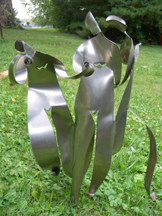Serendip is an independent site partnering with faculty at multiple colleges and universities around the world. Happy exploring!

2011 Artists Spotlight from Advocate

Diva 4, Kurt Kauper
Check out Advocate editors favorite art pieces from 2011 here.
This painting by Aaron Smith is my favorite! What's yours? Maybe one way this class site can continue is each of us keeping an eye out for our favorite art piece entangled with gender and sexuality during 2012? Post here!

Rip-staver, Andrew Smith
------
Wishing you a rejuvenating, relaxing, refreshing start to 2012.

Self Evaluation
While I have been, I think, pretty vocal about what I like and dislike about this class, I have decided to keep my evaluation private. The reasons for this are varied and complex, and I won't bore you with the details. In any case, I will be emailing my evaluation to Anne and Kaye. It's been a pleasure.

My Final Diffraction
This diffraction is not easy for me to write. I think that’s because this class has left me feeling largely confused. When we began the class, I saw myself as someone who loved Gender and Sexuality Studies—not so much the theories behind them as the case studies I read about and saw all around me (as a Biology major, I’ve noticed that I tend to reject the idea that one theory can explain all of gender or all of society—I think this is because in anthropological sense, there is no theory that computes to a scientific law. This is, for me, a weakness and a strength). The first reading by Barad caused me some distress, because I couldn’t understand why we were working so hard to connect physics and gender. In my mind, physics and gender both connect to everything else (indeed, if you get philosophical enough, everything connects to everything else), but that doesn’t mean we should spend our time dissecting the connection.
After Barad, I was further confused by the focus the course took on disability. I think disability is an important topic, and one that merits discussion, but I didn’t feel like our discussions ever had anything to do with gender. Once again, the sheer interdisciplinary-ness of the course had me feeling lost.




